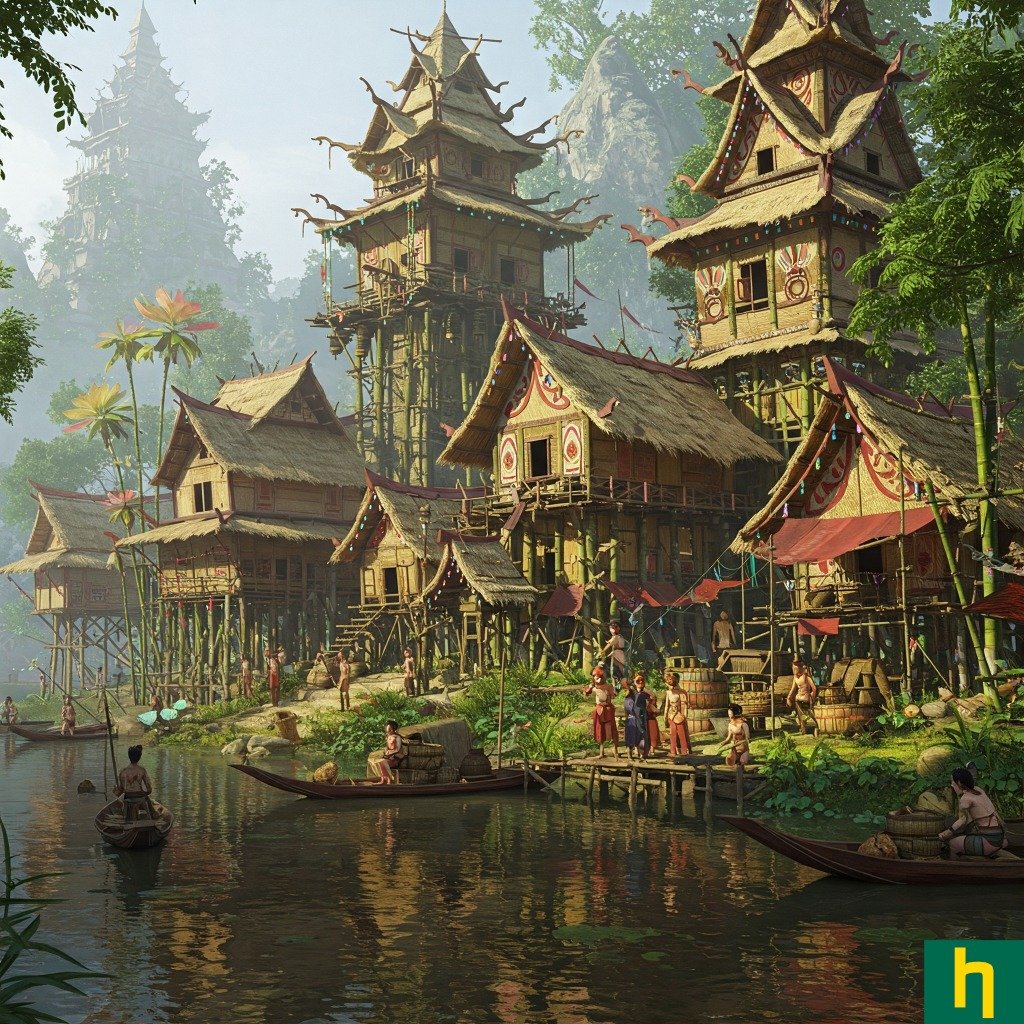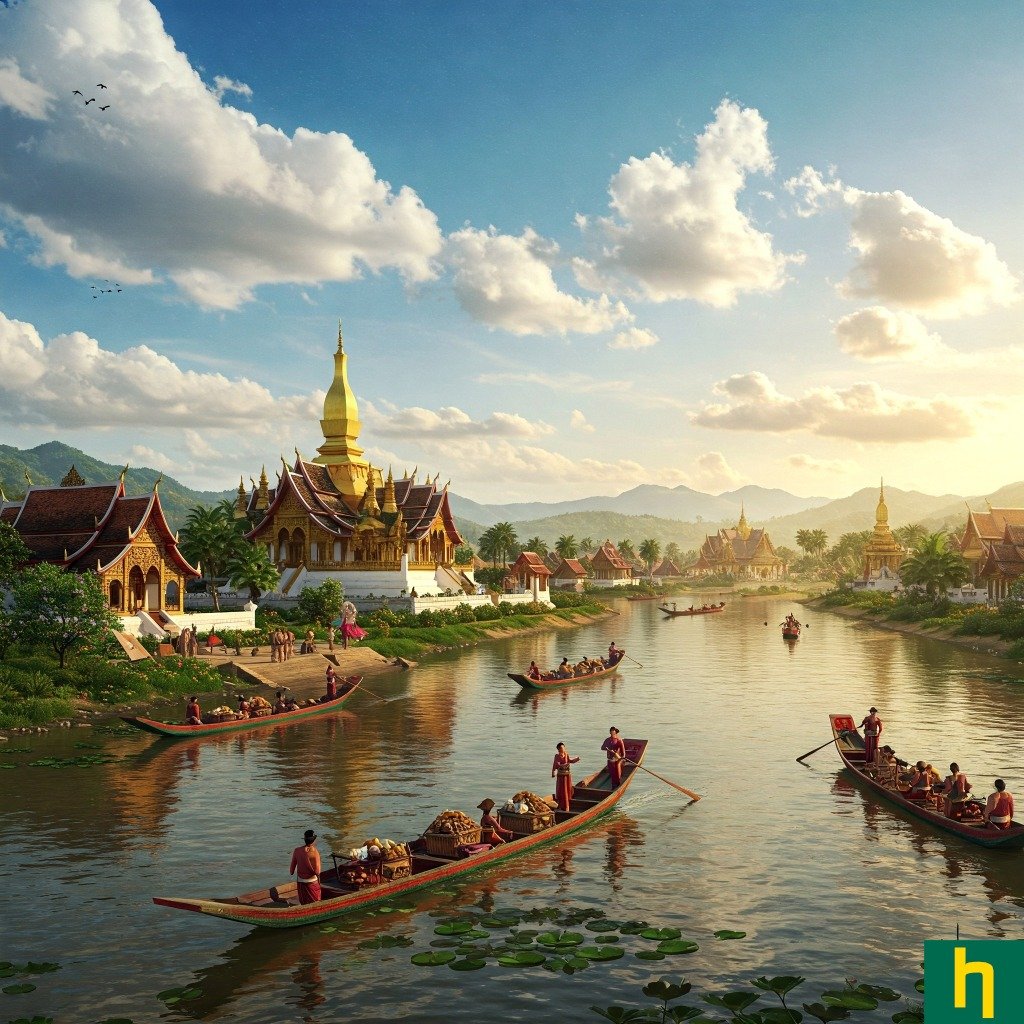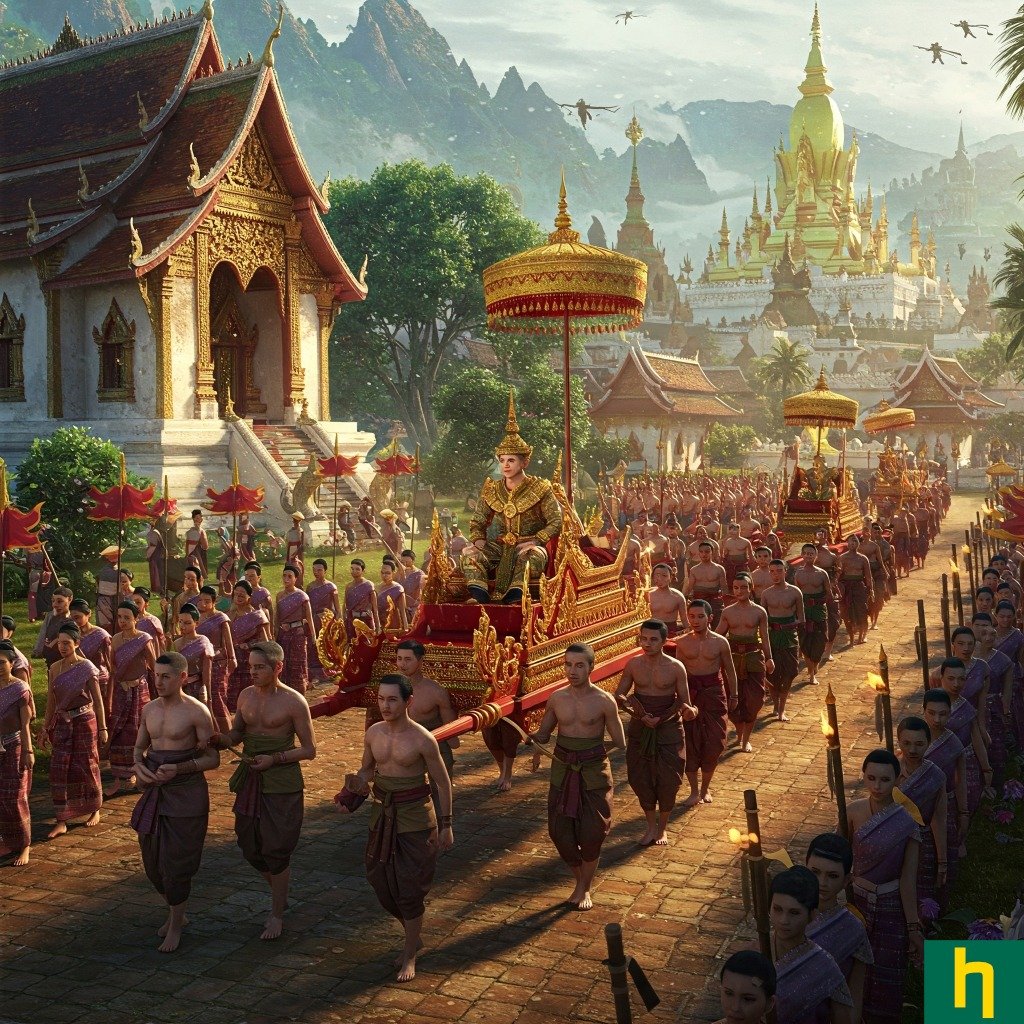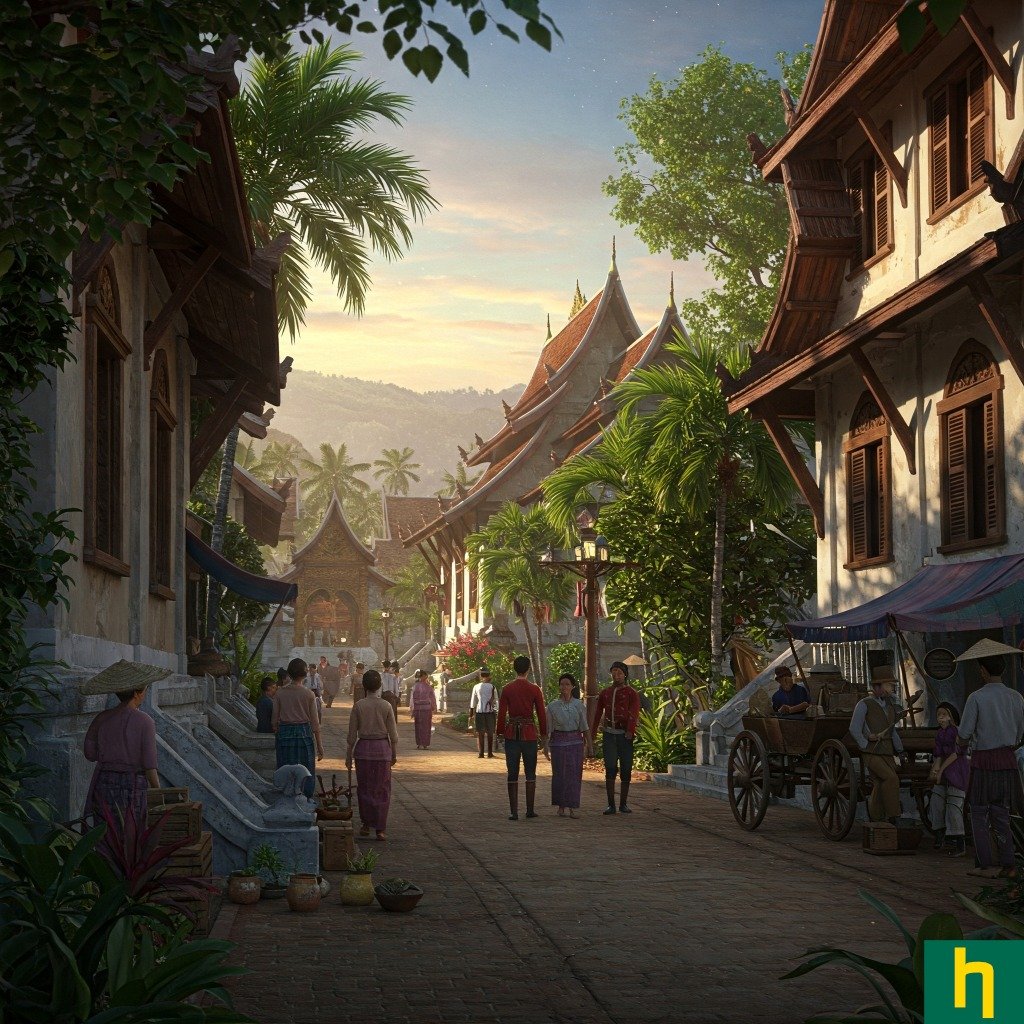Luang Prabang UNESCO World Heritage site, is a place to forget the frenetic pace of modern capitals. Here, time slows to the rhythm of chanting monks and the sway of palms. For centuries, Luang Prabang, situated at the confluence of the Mekong and Nam Khan rivers, served as Laos’s royal and spiritual heart. The processions of elephants, and the air alive with the sounds of royal ceremonies, are a legacy that earned Luang Prabang UNESCO’s coveted status in 1995.
The History of Luang Prabang: Mua Sua

Luang Prabang UNESCO World Heritage site, is a popular tourist destination today. But let’s go back to the genesis of what we know as Luang Prabang. There were no grand processions or booming empires. It was a more subtle beginning in the 8th century. This wasn’t yet the regal capital that would later command the “Land of a Million Elephants,” but a smaller entity known as Muang Sua.
Small communities began to take root. Historical records are scarce. Fragmented chronicles hint at early Lao settlements and the gradual influence of different cultures. Some tales speak of Khun Lo, a mythical figure whose story is woven into the local folklore.
In its infancy, it was a vital link in the chain of early Southeast Asian settlements. It wasn’t yet a beacon of spirituality but rather a humble place, quietly finding its own cultural identity.
Luang Prabang’s Golden Age

The 14th to the 16th centuries saw the humble Muang Sua emerge as the heart of the Lan Xang Kingdom – the “Land of a Million Elephants.” Luang Prabang was no longer a quiet riverside settlement, but now a capital with power and spirituality.
Exiled as a child from Muang Sua, Fa Ngum is credited with the founding of the Lan Xang Kingdom. In the mid-14th century, and with Khmer backing from Angkor, he returned with an army of ten thousand men to become its ruler. Helping him to solidify his rule was a sacred Buddha image that became the spiritual symbol of the city.
Luang Prabang began to flourish. Envoys arrived from distant kingdoms, as did traders from far and wide. The royal court, over time, became a scene of elaborate rituals, graceful dancing, and a place for learned scholars. Lao art and literature boomed. Whilst magnificent temples were constructed. This kingdom was confident in its newfound power and was deeply devoted to its spiritual identity.
The Lan Xang era wasn’t just about territorial expansion; it was a cultural blossoming with heavy influences from Khmer culture because of
Fa Ngum’s early years in the royal courts of Angkor influenced his Lan Xang rule. Here was a kingdom that wasn’t just about territorial expansion; it was a rich culture of Hindu and Buddhist traditions. It was a time of gentle Laotian charm that we still sense to this day. It was a kingdom at the zenith of its power and status.
Sacred Seat of Power

Eventually, the administrative reins of the Lan Xang Kingdom moved to Vientiane. But Luang Prabang retained its mystical significance. Luang Prabang remained the spiritual lodestar, the repository of royal traditions and home of the Phra Bang Buddha.
Royal barges sailed up and down the Mekong carrying monarchs back to the sacred city. Royal processions, perhaps less frequent, would still find their way back to Luang Prabang. The coronation of a new king, royal pilgrimages reaffirmed the connection to Lan Xang’s spiritual roots.
The concentration of temples within Luang Prabang solidified its sacred status. Luang Prabang held a moral and spiritual sway over the kingdom. It was the keeper of the kingdom’s most sacred icon, the stage for important religious rituals, and the embodiment of its enduring cultural soul.
Echoes of Indochina

Fast-forward to Luang Prabang’s encounter with French Indochina in the late 19th century. The arrival of French administrators and architects left an indelible mark. It wasn’t a forceful imposition, but a gradual intermingling.
The urban landscape has transformed. Teakwood homes, raised on stilts, began to share the streets with European-style villas and the grace of the neoclassical. French-era buildings stood alongside the gilded roofs of ancient wats.
Lao artisans began to incorporate European design, creating a unique fusion of styles. Charming cafes appeared and became social hubs for Lao royalty and French residents alike.
But it wasn’t just architecture in which the best of French culture was appreciated. The introduction of new French culinary traditions, mixed with the local cuisine, became popular.
Yet, through it all, Luang Prabang retained its Laotian soul. Monks continued their daily alms round, and so the spiritual heart of Laos continued, but beneath the veneer of colonial influence. The grand festivals and traditional ceremonies persisted. The French presence, arguably, added a layer of sophisticated charm to Luang Prabang’s allure.
Luang Prabang UNESCO World Heritage Site
For the heritage lover, the Luang Prabang UNESCO World Heritage site, centuries of culture are waiting to be discovered. Forget the checklist mentality of conventional tourism; Luang Prabang’s heritage isn’t a static snapshot. Wander the town’s unhurried lanes, you’ll experience an architectural conversation unlike any other; that of Lao wooden houses, in dialogue with the pastel colours of French colonial villas.
But heritage tourism in Luang Prabang isn’t confined to its charming world heritage centre. Go beyond, and you’ll discover the natural wonders that frame Luang Prabang’s cultural treasures. Cruising the majestic Mekong, past sleepy villages and stunning landscapes, you’ll sense a connection between the people and their river.
Luang Prabang engages you. Its traditions seep into your consciousness. It’s a destination that rewards those who crave authenticity and those who are willing to slow down and truly connect with the soul of a place.
Luang Prabang UNESCO site – Places to Visit
Wat Xieng Thong
This temple is so exquisitely crafted with the essence of Lao heritage that it once served as the personal sanctuary for the Lao monarchy. Wat Xieng Thong, the “Golden City Temple,” is a jewel in Luang Prabang’s glittering heritage crown.
The temple’s multi-tiered rooflines are classic Luang Prabang architecture, cascading downwards like a waterfall of dark, aged wood. Designed to protect the inner sanctum from tropical downpours, it is as practical as it is artistic in design.
On the western exterior of the ordination hall is a mesmerising mosaic. Crafted from countless fragments of colored glass, it depicts a Bodhi tree. Sunlight catches the tiny shards, showing us a scene with mythical creatures and swirling foliage.
One of Wat Xieng Thong’s most unique treasures is the former royal funeral carriage house. Under a protective roof is a beautiful gilded carriage, an elaborate creation used for royal cremations. Adorned with mythical naga serpents and intricate, it gives us an insight into the fantastic rituals of the Lao monarchy.
Visiting Wat Xieng Thong immerses the visitor into the spiritual heart of Luang Prabang. Allow yourself ample time to wander its grounds, to absorb all the intricate details of this amazing place.
Wat Mai Suwannaphumaham
Wat Mai Suwannaphumaham, often simply referred to as Wat Mai, captivates us not just with its spiritual aura but also with the stunning artistry of its golden façade. Situated in the heart of this small city, for a time, this temple served as the residence of the Supreme Patriarch of Lao Buddhism.
Intricately carved and gilded panels of gold leaf basking in sunlight catch the eye. As well as depictions from the Ramayana. Marvel at the heroic exploits of Prince Rama, the antics of Hanuman, and the battles against the demon king Ravana, all rendered with an eye for stunning detail.
Built in the late 18th century during the reign of King Anourouth, this temple became one of the town’s most important temples. Local lore recounts that the shimmering gold leaf was intended not only to beautify the temple but also to symbolise the wealth and prosperity of the kingdom.
Beyond the dazzling façade, the interior, while more subdued, offers its sense of serenity. Pillars adorned with carvings support the high ceilings, and the light filtering through illuminates the Buddha images within, creating an atmosphere conducive to quiet contemplation that all Buddhists crave.
Wat Sensoukharam
Wat Sensoukharam, often simply called Wat Sen, means “Temple of 100,000 Treasures.” Unlike the intricate Wat Mai or the mosaic artistry of Wat Xieng Thong, Wat Sen’s defining feature is its dramatic golden entrance. The shimmering portico catches the sunlight in a dazzling display at sunrise and sunset.
Beyond the entrance, you’ll encounter a traditional Lao temple layout. Revered Buddha images and the surroundings offer pockets of serene tranquillity. Wander the courtyard, observe the rituals, and take time to appreciate the spirituality residing within its golden walls.
Navigating the Luang Prabang UNESCO Heritage Site
Perhaps the best way to see the city’s charms is on foot. Its compact historical centre unfolds like a beautifully preserved storybook.
Walk along Sisavangvong Road, as it transforms into the quaint night market at dusk. Get pleasantly lost, amongst the meandering lanes and sois; witness monks tending to temple gardens, or observe children playing traditional games.
Or, ride a tuk-tuk and venture further. Unlike the chaotic tuk-tuk journeys of Bangkok or Chiang Mai, in Luang Prabang, the tuk-tuk is still a delightful mode of transport. Negotiate your fare with a smile and settle in for a breezy ride to the Kuang Si Falls or the pier for a Mekong River excursion. Your driver, often with a wealth of local knowledge, might even share a bit of the town’s history.
Alternatively, embrace the leisurely pace by renting a bicycle. The flat terrain makes it ideal for two-wheeled exploration. Cycle along the Mekong Riverbanks, past traditional architecture, rice paddies and sleepy villages.
Tips For Serene Navigation
Embrace the Early Hours: Rise with the sun to witness the magical alms giving ceremony and see the town in its most peaceful state.
Dress Respectfully: When visiting temples, make sure your shoulders and knees are covered, reflecting the reverence of these sacred spaces.
Mindful Photography: Be mindful when and where you point your camera, particularly during religious ceremonies. Observe with respect and avoid intrusive flash photography.
Savour the Moments: Resist the urge to rush from one sight to the next. Sit by the river at sunset or observe the rhythm of monastic life. Luang Prabang is an exercise in slowing down. Savour the journey, one gentle step, one leisurely cycle, at a time. For heritage-loving tourists, it’s a balm for the soul.
Luang Prabang UNESCO: Preserving The Past
Luang Prabang, in its wisdom, understands the balance between centuries of heritage and the modern world. Achieving a world heritage listing ensures progress doesn’t come at the cost of the city’s soul.
Living heritage must breathe and evolve. The challenge is managing the influx of visitors. Guidelines encourage respectful engagement with local customs. Daily alms giving ceremony, for example, remains a sacred ritual, not just a selfie op.
Young entrepreneurs are finding ways to showcase Lao culture in contemporary ways. The aim is to blend tradition with modernity in a way that feels authentic. For the discerning traveller, it offers a reassuring vision: a Luang Prabang where history resonates.
Luang Prabang UNESCO heritage city, doesn’t shout out its charms. It invites you to lean in and listen to tradition and the smiles of its people. It reminds its visitors that true luxury can be found in the genuine connection with a local culture. So, if you’re thinking of packing your bags to visit, know that you aren’t just visiting a place; you’re embarking on a journey into a living heritage.
Luang Prabang FAQs
Why was Luang Prabang inscribed as a UNESCO World Heritage Site?
Luang Prabang was designated a UNESCO World Heritage Site in 1995 for its unique and well-preserved townscape that showcases a fusion of two distinct cultural traditions. The city’s outstanding universal value lies in its successful blend of traditional Lao wooden houses and Buddhist temples with European colonial-era buildings, creating a harmonious and beautiful urban landscape.
What historical periods shaped Luang Prabang’s unique architecture?
The city’s architecture is a testament to its long and layered history. It began as a religious and royal centre of the Lan Xang Kingdom, which developed distinct Lao architectural styles. Later, the arrival of French colonial authorities in the 19th century introduced European-style villas and administrative buildings. The result is a unique combination of Lao traditional architecture and French colonial villas.
What is the spiritual significance of Luang Prabang?
Luang Prabang has long been the spiritual heart of Laos. It was the royal capital and home to the sacred Phra Bang Buddha image, which gave the city its name. Even after the administrative capital moved to Vientiane, it retained its religious importance, with daily monastic life and ceremonies, such as the alms-giving ritual, continuing to be central to the city’s identity.
What are some of the iconic landmarks that reflect its UNESCO status?
The city’s UNESCO status protects over 600 buildings. Key landmarks that showcase the blend of cultures include the Royal Palace (now the National Museum), which combines traditional Lao design with French influences, and the magnificent Wat Xieng Thong temple, a prime example of classic Luang Prabang temple architecture. The daily alms-giving ceremony also highlights the city’s living cultural heritage.
How does Luang Prabang’s UNESCO status impact its preservation and tourism?
The UNESCO designation brings both a high honour and a significant responsibility. It has helped protect the city from rapid, uncontrolled development and has led to rigorous conservation efforts. The status also requires careful management to balance the influx of tourism with the preservation of its fragile historical structures and intangible cultural traditions, ensuring the city’s unique charm is maintained for future generations.

